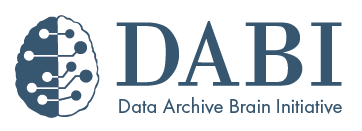Data Archive for the BRAIN Initiative (DABI)
Type: Software,
Keywords: Human, EEG, Neurophysiology, Imagine, ECoG, MRI, Analytics, Dissemination, Open-access, Harmonization

A shared repository for invasive neurophysiology data from the NIH BRAIN Initiative
DABI is a web-accessible data archive that captures, stores, and curates human invasive neurophysiology data from BRAIN Initiative proposals. These data are aggregated, organized, and disseminated to the research community to accelerate the pace of discovery in the neurosciences. In addition to its archival and organization services, DABI also integrates novel analytical tools for cohort discovery and preliminary analyses.
* Ingest and Archive data: An efficient, secure, HIPAA-compliant data repository platform
* Quality Control: A multi-center data review and assessment system that preserves data quality, fidelity, and provenance
* Harmonize Data: A common model comprised of common database schema, data dictionary and code lists
* Search, Download, and Support: Mechanism and regular training sessions to increase the ease of data aggregation and the downloading of large datasets
* Interactive Data Visualization: Spatially normalize data and create subject cohorts to search, compare and download data
* DABI can be used to store, process, share, and analyze data types spanning many different modalities and formats.
* A data provider may upload ECoG, preoperative and post-operative imaging, behavioral, and demographic data during ongoing or after the completion of a clinical trial investigating the effects of deep brain stimulation on obsessive compulsive disorder.
* A data user may pool together a cohort of several subjects spanning many studies examining LFPs in the motor cortex in order to research the brain’s response to observed movement.
* A data user may utilize several tools to analyze pooled subjects across institutions within the DABI site.
* Human
* Web-accessible
* Open-access
* On-site visualization
* On-site analytical tools
* Central data storage
* Easily shareable
* No standard file formats required
* No standard file format requirement means that there may be several file types for one data type
* Data providers and data users must make a DABI account prior to uploading or accessing data.
Sendi MSE, 2021, Intraoperative neural signals predict rapid antidepressant effects of deep brain stimulation, Translational Psychiatry, doi:10.1038/s41398-021-01669-0
Mujica-Parodi LR, 2020, Diet modulates brain network stability, a biomarker for brain again, in young adults, Proceedings of the National Academy of Sciences, doi:10.1073/pnas.1913042117
Magnotti JF, 2020, RAVE: Comprehensive open-source software for reproducible analysis and visualization of intracranial EEG data, NeuroImage, doi:10.3389/fnhum.2021.717401
Tchoe Y, 2022, Human brain mapping with multithousand-channel PtNRGrids resolves spatiotemporal dynamics, Science Translational Medicine, doi:10.1126/scitranslmed.abj1441
Nakhmani A, 2022, Cortical and STN spectral changes during limb movements in PD patients with and without dystonia, medRxiv, doi:10.1101/2022.01.04.22268757
Rubel O, 2021, The Neurodata Without Borders ecosystem for neurophysiological data science, bioRxiv, doi:10.1101/2021.03.13.435173
Weistuch C, 2020, Younger, but not older, brains are poised at a critical point of functional activity, bioRxiv, doi:10.1101/2020.04.17.047233
Weistuch C, 2020, Metabolism modulates network synchrony in the aging brain, bioRxiv, doi:10.1101/2020.04.17.047233
Provenza NR, 2021, Long-term ecological assessment of intracranial electrophysiology synchronized to behavioral markers in obsessive-compulsive disorder, Nature Medicine, doi:10.1038/s41591-021-01550-z
Schmitgen A, 2021, Musical Hallucinations in Chronic Pain: The Anterior Cingulate Cortex Regulates Internally Generated Percepts, Frontiers in Neurology, doi:10.3389/fneur.2021.669172
Van Horn JD, 2021, Bridging the Brain and Data Sciences, Big Data, doi:10.1089/big.2020.0065
Woolnough O, 2022, Dataset of human intracranial recordings during famous landmark identification, Scientific Data, doi:10.1038/s41597-022-01125-8
Jwa AS, 2022, The spectrum of data sharing policies in neuroimaging data repositories, Human Brain Mapping, doi:10.1002/hbm.25803″
Arthur Toga, Professor
University of Southern California, Los Angeles, CA
TEAM / COLLABORATOR(S)
Dominique Duncan, Assistant Professor of Neurology, Neuroscience, and Biomedical Engineering, University of Southern California
Nader Pouratian, Lois C.A. and Darwin E. Smith Distinguished Chair in Neurological Surgery, UT Southwestern Medical Center
Arthur Toga, Director of USC Mark and Mary Stevens Neuroimaging and Informatics Institute, University of Southern California
FUNDING SOURCE(S)
* R24MH114796

